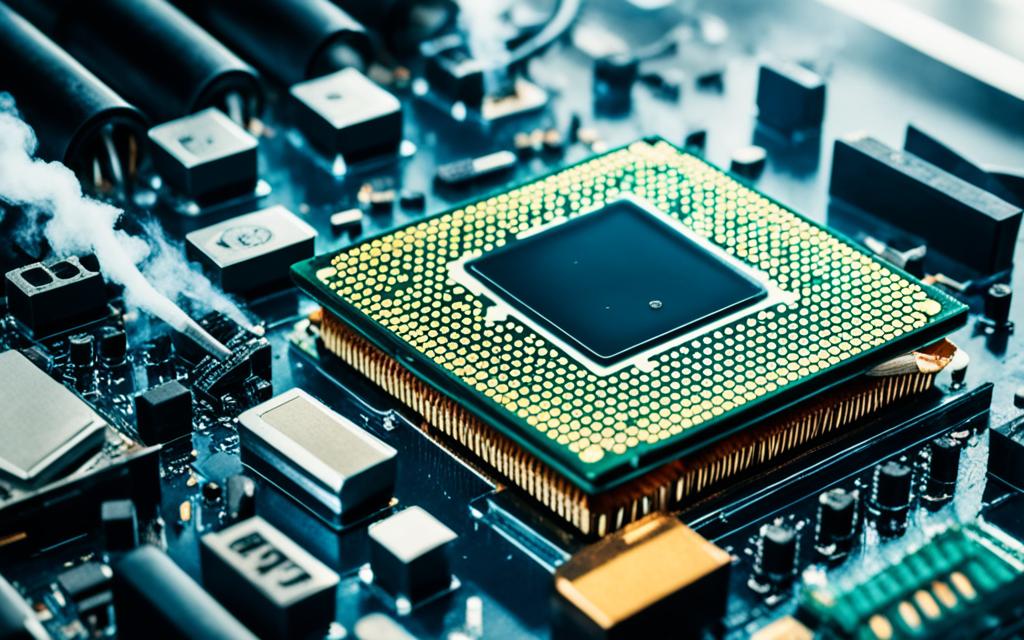Table of Contents
The Central Processing Unit, or CPU, is like your computer’s brain. It follows instructions and does calculations. But if it starts to fail, your computer can slow down or crash. Spotting early signs of CPU troubles can stop big problems later. Signs of a problem include your system freezing suddenly or problems starting up with a blank screen. You might also see your computer shutting down by itself or getting the Blue Screen of Death (BSoD) with error codes like 0x00000.
Other signs are noises like a series of 5-7 beeps when you turn on your computer. This means something might be wrong inside. Look for physical signs too, like burnt marks near the CPU spot. These marks mean the CPU might be getting too hot. It’s a warning to take action and check your CPU. For tips on setting up a PC, check out setting up your gaming PC1.
Key Takeaways
- The CPU is key for keeping your computer stable; knowing when it’s failing is important.
- Physical damage, including burn marks, suggests CPU issues.
- System freezes and unexpected shutdowns are common warning signs.
- Beep sounds when starting up can hint at problems.
- Looking after your CPU well can prevent bigger issues.
- Watch out for BSoC error codes that suggest CPU failure.
Understanding the Role of the CPU
The CPU is the heart of any modern computer, responsible for executing instructions and managing data. It relies on understanding both hardware and software commands to do complex jobs. This shows why picking the correct computer components is crucial.
What is a CPU?
The Central Processing Unit (CPU) is like the brain of the computer. It controls all operations, making sure information is processed quickly. Every task, like opening apps or saving files, depends on the CPU’s efficiency. Spotting issues early can stop many problems, such as crashing CPUs, which cause system failures2.
Common signs of a CPU problem include a computer that won’t start, a black screen, beeps, freezing, or slow performance. These issues underline how important the CPU is for the computer to work well2.
How the CPU Communicates with Other Components
The CPU mainly talks to other parts through the motherboard. It connects with key computer components like RAM, storage, and graphics units. Good communication is key. Any breakdown here might mean there are hidden problems. Signs of these issues include freezing during use, suggesting CPU or RAM problems3.
For instance, if there’s no video, the CPU might not be working right. This shows how vital the CPU’s job is in getting and showing data2. Using tools to check on the CPU, like CPU-Z for temperatures and voltages, helps catch problems before they get worse2.
Common Symptoms of a Failing CPU
Knowing when a CPU is failing is key to keeping your computer healthy. You might see worrying signs that point to big problems. Look out for system crashes and a drop in how well your computer works.
Frequent System Crashes
One clear sign your CPU is not okay is when your system crashes a lot. This means your computer could suddenly turn off or restart. It’s annoying and could cause you to lose important work. If this happens often, your CPU might be the reason4.
Your computer might also freeze up and need a restart4. Trouble starting the computer, like being stuck in a loop of restarting, is another bad sign4.
Significant Performance Degradation
If your computer has started to slow down, it could be the CPU’s fault. This is especially true for tasks that were fast before. Games and other hefty apps might lag or freeze because of this3.
You might notice your system struggling with simple tasks3. Making sure the CPU doesn’t get too hot is important because overheating damages it5.
How do I know if my CPU is bad?
To spot a bad CPU, look out for certain signs. Start by checking for any physical damage. This is a quick way to tell if something’s wrong.
Physical Signs of Damage
Different signs can show up. Look for any burnt spots near the CPU socket. Melting on parts close to it means overheating damage. If your computer shuts down suddenly and often, it might be the CPU4. It’s good to pay attention to strange beep sounds when you turn on your PC. They could mean CPU problems.
Software Indicators of CPU Issues
Software issues can also hint at CPU problems. If your computer freezes randomly after logging in or while working, take note. This could mean the CPU is failing4. The dreaded Blue Screen of Death, along with system crashes or freezes, also points to CPU trouble34. Keep an eye on your PC’s temperature too. High temperatures could mean the CPU is overheating. Almost half of CPU failures come from overheating3. Monitoring these signs helps catch issues early on.
Causes of CPU Problems
It’s vital to know what causes CPU problems to keep your computer running well for longer. Main issues include overheating, dust buildup, and electrical problems.
Overheating and Thermal Issues
Overheating is a big problem for CPUs, often due to not enough cooling or too much work. If a CPU gets too hot, the system might slow down or turn off to avoid damage. This shows we need to make cooling better6.
Keep an eye on how hot it gets and make sure air moves well inside the case. This can stop serious overheating3.
Dust Accumulation and Its Effects
Dust can really block airflow and lower cooling, making overheating worse. This can lead to CPU damage6. Cleaning regularly helps keep the CPU working right.
Electrical Problems and Power Supply
Electrical issues can mess with how the CPU works because unstable power supply leads to unexpected behaviour. Things like power going up and down can make the computer turn off by itself or work oddly1. Good power supply and watching out for electrical issues are key to protect the CPU3.
https://www.youtube.com/watch?v=W4n4Wwmm7MA
Diagnosing CPU Issues
To find CPU problems, you need to be thorough and use special tools. Using CPU monitoring software helps track key data in real-time. This way, you can spot problems before they get worse.
Using Monitoring Software
Use tools like HWiNFO or the Intel Processor Diagnostic Tool to keep an eye on CPU health. These tools show important numbers, like how hot the CPU is and how much work it’s doing. If the CPU gets hotter than 50 degrees Celsius, you need to cool it down fast7.
Checking your CPU often lets you catch odd behaviors. This could be the heat shooting up suddenly or the CPU working in unexpected ways.
Running Stress Tests
Stress tests push your CPU hard to see how it handles intense work. Tools like Prime95 are used for this. These tests show if the CPU can keep up under pressure or if it might fail. If your computer stops working during these tests, it could mean big trouble8.
Drawing a lot of power during these tests might show problems with how your computer uses resources or potential hardware limits9.
Checking BIOS/UEFI Settings
Looking through BIOS/UEFI settings might reveal errors or wrong settings that affect the CPU. The right settings are key for top CPU performance and stability. Wrong settings might cause your computer to not start or to show a blue screen, telling you there’s a CPU problem to fix7.
Basic Fixes and Preventative Measures
Keeping your CPU in top shape requires some basic steps. It’s important to do simple tasks that help your computer’s cooling system work better. This ensures a stable power supply too.
Cleaning and Improving Cooling Systems
Cleaning your CPU regularly is important. Dust can block airflow and make your CPU overheat. By cleaning fans and heatsinks, you keep air moving as it should. This stops your CPU from getting too hot.
Proper Power Supply Management
Your CPU needs stable power to last longer. When the voltage changes too much, it can harm the CPU. Using good quality power supplies and checking them often reduces this risk. This is an important step to keep your CPU working well.
Avoiding Overclocking
Overclocking makes your CPU work harder than it should. This extra stress can make it overheat and even fail. Keeping your CPU at its normal settings helps it run smoothly. Regular checks ensure it stays within safe limits.
Conclusion
Knowing when things are going wrong is crucial for your computer to run smoothly. Understanding the CPU and spotting signs like crashes or slow performance helps you figure out CPU problems. To keep your computer working well, it’s important to check the CPU often and take steps to care for it. For tips on dealing with CPU issues, staying up-to-date with problem-solving methods is key.
Taking steps to prevent problems, like keeping the CPU clean and managing its power, can help avoid many issues. Interesting to note, some have found crashes often link not to the CPU, but to power supply problems10. Regularly inspecting your computer physically and doing stress tests can reveal hidden issues that might risk your system’s health11.
In short, acting before problems occur is the best strategy to dodge CPU-related failures. Doing regular checks and learning how to avoid issues can ensure your computer lasts longer. Keeping your CPU in top shape means better performance of your computer overall12.
FAQ
What are the common symptoms of a bad CPU?
If your CPU is in trouble, you might see your computer crash a lot. You could also notice it slowing down for no clear reason. And, you might see the dreaded Blue Screen of Death (BSoD).
How can I tell if my CPU is overheating?
Check for signs like burn marks around the CPU socket. Melting on components nearby can also be a clue. You can also use monitoring software to watch for high temperatures.
What causes CPU problems?
Many things can cause CPU issues. Overheating is a big one, often because cooling isn’t good enough. Dust can block airflow, and unstable power can mess with the voltage. Pushing the CPU too hard with overclocking is another common cause.
How do I diagnose CPU issues effectively?
To figure out CPU problems, monitoring software like HWMonitor can help. This lets you keep an eye on temperature and voltage. Stress tests, like Prime95, are good for checking how it does under pressure. Also, look at BIOS/UEFI settings for any wrong setups.
What basic measures can I take to maintain CPU health?
For good CPU health, keep cooling systems clean. Make sure your computer case has good airflow. Manage your power well to avoid harmful fluctuations. Try not to overclock, as it adds stress on your CPU.
What role does the CPU play in a computer?
The CPU is like the computer’s brain. It does the thinking by following instructions and doing calculations. It works with other parts through the motherboard. This keeps the system running smoothly.
How can I recognise the indicators of CPU failure?
You can spot CPU failure by listening for unusual beep codes when starting up. Persistent error messages when booting up are another sign. Also, if your system keeps having performance issues, check the system logs.
Source Links
- https://computingaustralia.com.au/understanding-cpu-processor-failure-symptoms/ – Understanding CPU (Processor) Failure Symptoms
- https://www.linkedin.com/advice/1/what-best-way-diagnose-repair-malfunctioning-cpu-ogf0e – What is the best way to diagnose and repair a malfunctioning CPU in a computer?
- https://apexgamingpcs.com/blogs/apex-support/how-to-tell-if-cpu-is-bad – How to Tell if Your CPU is Bad With Fixes
- https://www.pcguide.com/cpu/how-to/tell-is-failing-or-dead/ – How to tell if your CPU is failing or dead – 7 signs to look for
- https://www.jbit.tech/single-post/cpu-failures-causes-and-indications – CPU Failures: Causes and Indications
- https://www.ituonline.com/blogs/cpu-problems/ – Troubleshoot Computer Hardware Problems : CPU Problems – ITU Online
- https://proteksupport.com/diagnosing-cpu-issues/ – Diagnosing CPU Issues – Protek Support
- https://www.computerhope.com/issues/ch001089.htm – How to Test a Computer Motherboard and CPU for Failures
- https://unity.neuraldsp.com/t/not-enough-cpu-when-plenty-of-cpu/9787 – Not enough CPU when plenty of CPU
- https://community.spiceworks.com/t/how-do-i-check-if-a-cpu-is-getting-power/769800 – How do I check if a CPU is getting power?
- https://softwareg.com.au/blogs/computer-hardware/how-to-test-a-bad-cpu – How To Test A Bad CPU
- https://softwareg.com.au/blogs/computer-hardware/how-to-tell-if-cpu-or-motherboard-is-bad – How To Tell If CPU Or Motherboard Is Bad








